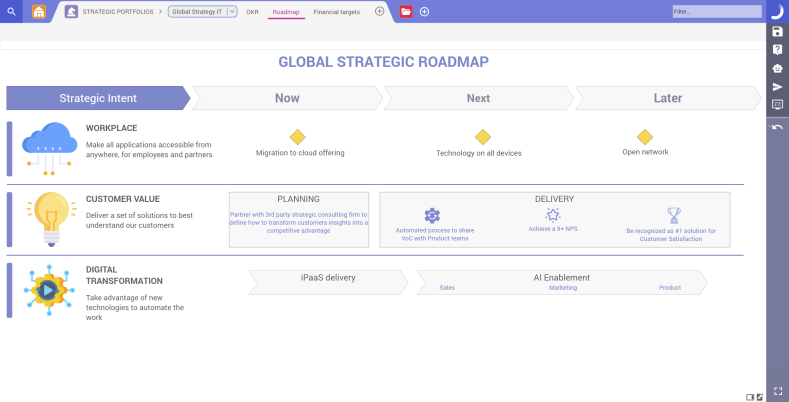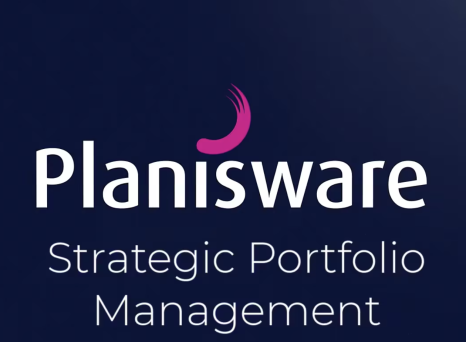What is strategic portfolio management (SPM)?
Strategic portfolio management (SPM) is a set of business processes, capabilities, and supporting technology that aid in selecting the right investments to meet strategic goals. It is an overarching, top-down approach managed at the top executive level of the organization.
The aim of SPM is to focus a business’s finite resources and capital on prioritizing projects, products, and services that execute its global, enterprise-wide strategy. It is a key part of modern business optimization, helping organizations meet the need for digital transformation, business agility, and a “single source of truth” in all operations.
With its focus on continuous analysis and delivery in line with strategic objectives, SPM helps businesses adapt quickly to change, remain competitive, and maximize business value. It can help with decision-making in relation to:
- large-scale business projects (such as exploring a new market or investing in new product development)
- major transformation projects (such as digitalization of a significant part of the business)
- major financial decisions (such as share buyback programs)
SPM provides a framework for centralizing projects at an enterprise level and creating a “golden record” for data. It is a holistic approach that promotes aligned practices, methods, strategies, and templates across the organization—improved governance, in other words–to enhance decision-making, accountability, and transparency.
Who is responsible for strategic portfolio management?
SPM is typically owned by senior executives and enterprise-level leadership. This ensures it reflects and drives the organization’s long-term vision.
It may involve the Chief Strategy Officer (CSO), Chief Executive Officer (CEO), Chief Financial Officer (CFO), Enterprise PMO (EPMO) leaders, business unit heads, and strategic planning teams. Some organizations may even define a dedicated strategic portfolio manager role.
These SPM leaders will define priorities, allocate resources, and ensure alignment across portfolios. Specific responsibilities can include:
- translating high-level vision into action, managing resources and budgets, and providing data-driven insights
- aligning projects and investments with enterprise goals and strategic priorities
- continuously evaluating, prioritizing, and adjusting initiatives and models based on performance, value, and changing needs
- monitoring portfolio health, including risks to business, financials, and timelines
- increasing project visibility and maintaining a “single source of truth” for stakeholders
- supporting scenario planning and real-time portfolio adjustments
- championing a culture of strategic alignment and outcome-focused execution
The role of strategic portfolio management tools
SPM is a completely customizable approach—every organization’s implementation will be different. However, it will always revolve around the adoption of a robust SPM software solution.
These tools provide a range of features and capabilities—such as real-time dashboards, strategic visual roadmapping, predictive AI analytics, and “what-if” scenario planning—that help bridge the gap between strategy and execution.
By integrating a range of data and providing clear visibility across initiatives, these SPM solutions empower decision-makers to prioritize the most strategically-aligned initiatives, allocate resources effectively, and ensure the business remains agile in the face of market changes.

Strategic axis roadmap in Planisware
What are the benefits of strategic portfolio management?
SPM ensures that organizational goals are the focus of projects and portfolios. By improving governance and processes, it helps organizations retain a competitive advantage and maximize their operational efficiency. Its benefits cover a number of key areas, including:
- Strategic alignment: SPM bridges the strategy-execution gap. It empowers leaders to turn a scattered range of projects, programs, resources, and investments into one cohesive strategy and continually evaluate their alignment with broader business objectives.
- Decision-making: By unifying all of your organization’s data in one place and providing dynamic insights, SPM helps leaders to make informed decisions at a faster speed and with greater confidence—possibly in relation to killing a project, redeploying misallocated resources, or giving the green light to a new investment.
- Business agility: By combining real-time data with agile processes, SPM empowers leaders to reprioritize projects and reallocate resources proactively and dynamically. This helps the business pivot and adapt nimbly in response to market shifts by combining a range of different initiatives into one cohesive strategy.
- Risk assessment: SPM builds in proactive risk management practices and processes, allowing leaders to identify (and act on) potential threats before they harm the organization—and possibly even turn them into opportunities.
- Collaboration: With its focus on creating a single source of truth across projects and portfolios, SPM streamlines cross-functional coordination. Team members can share timelines, identify risks, manage dependencies, and understand how investments contribute towards overarching strategic objectives.
- Visibility: By providing real-time access to enterprise-wide project and portfolio data—including information relating to status, costs, risks, and alignment with strategic goals—SPM provides greater levels of transparency and trust in the organization’s data.
- Accountability: Through standardization of processes and procedures, SPM establishes clear ownership of projects and outcomes. Decisions and their results are clearly traceable to individuals and teams.
What is the difference between project portfolio management (PPM) and SPM?
Project portfolio management (PPM) emerged in the early 2000s. It refers to the tools, methods, and strategies used to manage a specific project portfolio, which includes overseeing several connected projects with a shared goal or outcome.
SPM was introduced by Forrester in 2017 and is broader in approach and scope. As we mentioned earlier, it’s more top-down, focusing on enterprise-wide strategy-to-execution alignment and connecting activities, tasks, and portfolios to business outcomes.
PPM’s scope is selecting and managing value-driven projects and programs within a portfolio, while SPM’s scope is connecting enterprise-wide strategy with investment decisions. While decision-making in PPM may be driven by resource optimization and risk management, decision-making with SPM may focus on value creation and competitive positioning.
For rapidly-scaling businesses undertaking many high-stakes projects at once, the continuous planning, strategic alignment, and organizational visibility provided by SPM can make it a more agile solution.
However, despite being distinct methodologies, PPM and SPM can be complementary: both may exist within an organization’s portfolio management practices. In a nutshell, PPM is about doing things right, and SPM is about doing the right things.
For a more in-depth breakdown, check out our comparison of PPM and SPM.
Connect strategic vision to execution with Planisware
Named the “Customers’ Choice” in the 2024 Gartner® Peer Insights™ for Strategic Portfolio Management report, Planisware is trusted by global leaders and dynamic mid-size innovators alike.
With a range of industry-leading SPM capabilities, Planisware helps you communicate and connect your vision to every area of an organization. Book a live one-to-one demo and start your journey to better strategy-to-execution alignment.


